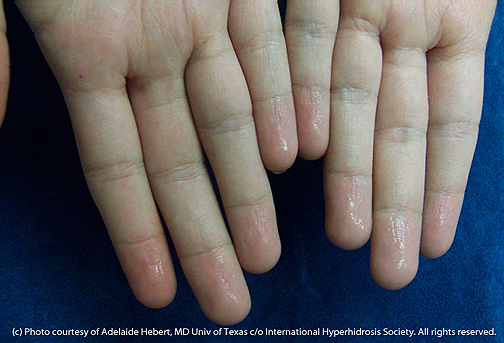

Excessive, uncontrollable sweating of the hands or palms, is called palmar hyperhidrosis. This medical condition is an extremely stressful, embarrassing, and confidence-wrecking problem. From ruined paperwork to slippery handshakes, sweaty palms can negatively impact your social life, education, and career.
Palmar Hyperhidrosis Clinical Trial Now Enrolling in Houston, TX (as of June 2025): If you’re 18 or older and experience excessive sweating of the hands, you may qualify for a local clinical trial testing a topical (on-the-skin) treatment for palmar hyperhidrosis. The study includes three clinic visits and two phone check-ins, with no cost to participate. To learn more or enroll, call (713) 500-8266 or (713) 500-8278.
It's proven and published that palmar hyperhidrosis has the most significant negative impact on patients' lives of any dermatologic condition.
But there are treatments available, the treatments work, and you have a number of choices.
The first line of defense against sweaty palms is an antiperspirant. That's right, you CAN use antiperspirants on your hands. Antiperspirants are non-invasive, topical (applied on top of your skin), and available in a number of different strengths including "regular" over-the-counter products, "clinical strength" over-the-counter products, and prescription products. You may have already tried the mildest formulations ("regular" over-the-counter products) and likely didn't get much relief. The next step is to try a stronger formulation. Learn about key choices on our Fan Fave Products page. All companies listed on the Fan Fave Products page proudly support the International Hyperhidrosis Society, have good customer reviews, and offer global shipping.
But before you work your way up to even stronger formulations (prescriptions) we suggest that you make sure you are using products to optimize their effectiveness and--importantly--minimize irritation. In fact, how you use antiperspirants is so important, we have a whole section dedicated to it, but the most important tidbits are:
If antiperspirants don't give you the palmar hyperhidrosis relief you need, your next option is iontophoresis. When the right device is used, and used correctly, iontophoresis has been proven to have impressive success rates (81% reduction in sweating according to a published study) for people with sweaty palms. Read all about it on our iontophoresis page (including tips on how to get the best results from this treatment), but here's a summary:
Another treatment option for sweaty palms is Botox (also known as onabotulinumtoxinA). An experienced medical professional can inject Botox into your palms to dramatically reduce sweating. Effects are lasting (about 6 months) but the injections can be painful. To help make the injections more comfortable, experienced medical professionals are turning to a simple icing and/or vibration technique, but be aware that discomfort during injections is a potential drawback of Botox treatment for palmar hyperhidrosis.

The use of Botox for the treatment of hyperhidrosis is most effective when performed by a healthcare professional who has received special training from the International Hyperhidrosis Society and who has experience with the procedure. To find a physician, nurse practitioner (NP), or physician assistant (PA) in your area who is familiar with hyperhidrosis treatments, use our Clinician Finder. And if you want to find one who has attended our Master Class in Hyperhidrosis, look for the "IHhS-Educated" notation in the Clinician Finder search results. You can also use the Advanced Search button to search for only those who have received training from the International Hyperhidrosis Society.
A newer prescription treatment, containing an anticholinergic medication that is applied to the skin, called Qbrexza may have promise for treating sweaty palms. Although the U.S. FDA approved this topical therapy to treat underarm excessive sweating, there is potential for this treatment to be used "off-label" for hands. IHhS co-founder and board member Dr. David Pariser has led research on the best technique for the use of Qbrexza for palmar hyperhidrosis. The study compared four different ways of using Qbrexza to manage palm sweating. Results were published in the May 2022 edition of Journal of Drugs in Dermatology. One hundred and twenty patients, age nine years or older with self-reported excessive palm sweating took part in the study, which lasted four weeks and consisted of one of four different daily palmar Qbrexza application routines. The study found that the application of the Qbrexza cloth onto both hands (until the cloth was dry or about 3 minutes), wearing clean cotton gloves for 30 minutes, and then washing the hands achieved the best sweat-reducing results with the most acceptable safety profile (fewest side effects). For this group, “hand sweat severity” dropped an average of 4 points out of a 10-point scale. To learn more about this research, read our blog or the full study.
While most people find that antiperspirants, iontophoresis, Botox injections, perhaps Qbrexza, or a custom combination of these are enough to manage excessive hand sweating, there are those who seek a more definitive course of action. If less invasive treatments have proven to be insufficient, endoscopic thoracic sympathectomy (ETS) may be considered as a last resort. ETS has significant risks associated with it, however, particularly a side effect called compensatory sweating (irreversible excessive sweating on large areas of the body) and should only be used in extreme cases after a thorough trial of all other options.
As of now, the options for treating palmar hyperhidrosis are not ideal. That's why we continue to advocate for hyperhidrosis research and donations. Both are vital if we are to finally find a safe cure for palmar hyperhidrosis.
We hope that you find the information on this site helpful and inspiring as you search for the best way to manage your sweating problem. For updates about new hyperhidrosis research, the latest hyperhidrosis treatments, and daily management tips, be sure to sign up to get our blog emails. We also have an extensive library of hyperhidrosis articles from peer-reviewed medical journals, so you can see where we get our facts, and you can share reliable medical data with your clinician.
Latest Blogs